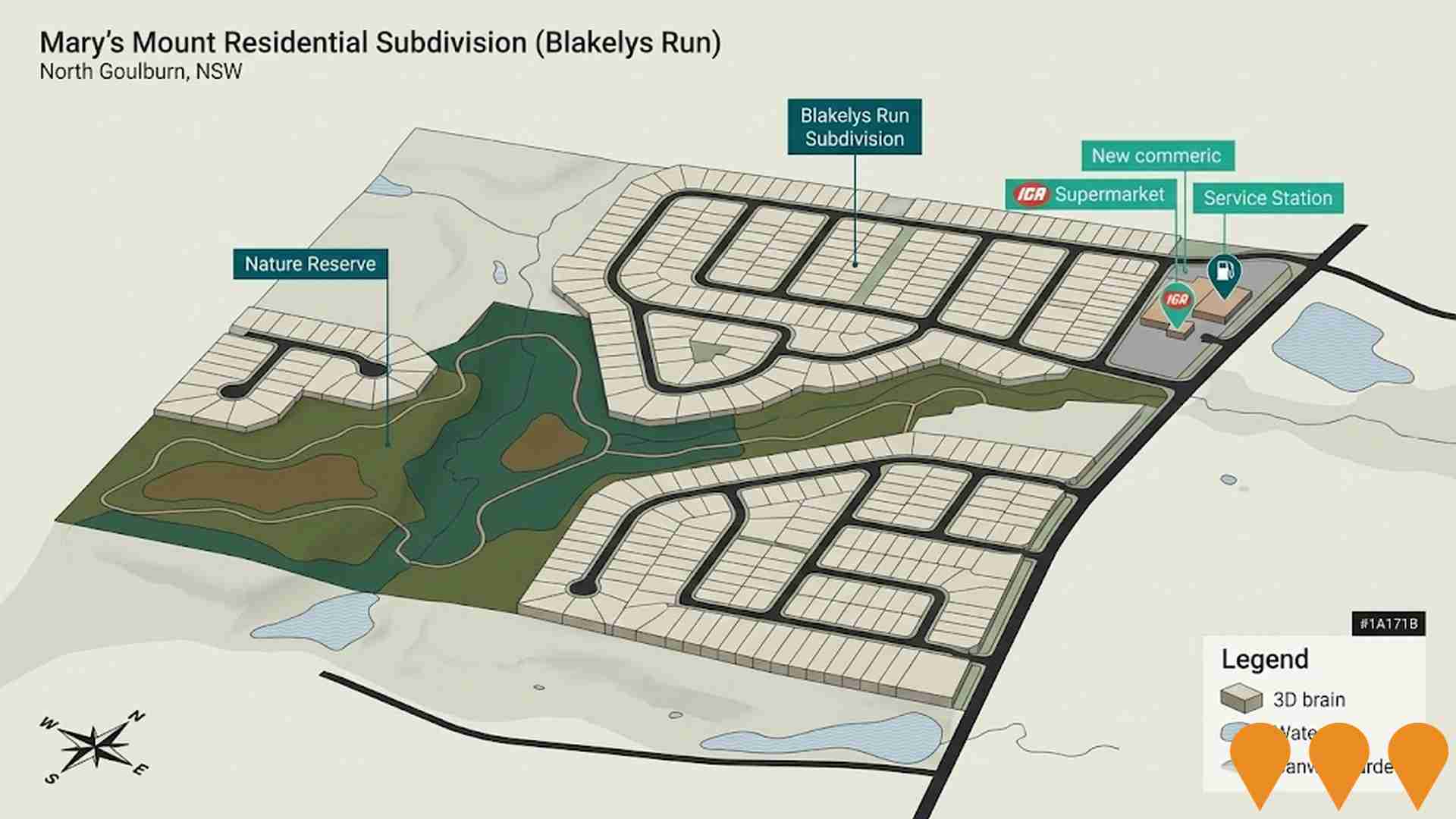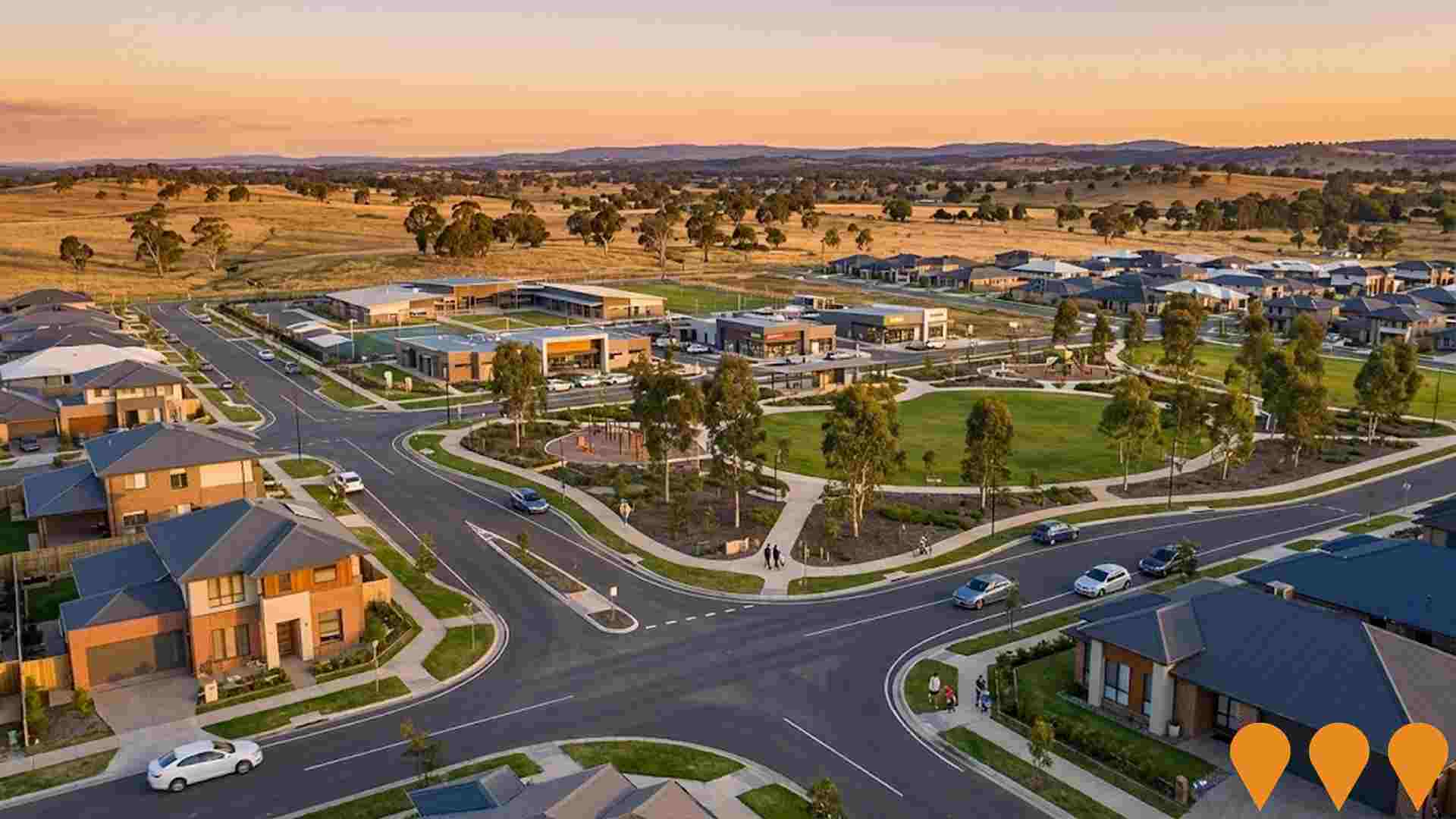Chart Color Schemes
est. as @ -- *
ABS ERP | -- people | --
2021 Census | -- people
Sales Activity
Curious about local property values? Filter the chart to assess the volume and appreciation (including resales) trends and regional comparisons, or scroll to the map below view this information at an individual property level.
Find a Recent Sale
Sales Detail
Population
Population growth drivers in Goulburn are strong compared to national averages based on AreaSearch's ranking of recent, and medium to long-term trends
Goulburn's population is approximately 26,264 as of November 2025. This figure represents an increase of 1,699 people (6.9%) since the 2021 Census, which reported a population of 24,565. The change is inferred from the estimated resident population of 25,308 in June 2024 and an additional 764 validated new addresses since the Census date. This results in a density ratio of 405 persons per square kilometer. Goulburn's growth rate exceeded that of its SA4 region (5.1%) and the non-metro area, indicating it as a growth leader. Overseas migration contributed approximately 87.6% of overall population gains during recent periods.
AreaSearch adopts ABS/Geoscience Australia projections for each SA2 area, released in 2024 with 2022 as the base year. For areas not covered by this data, AreaSearch uses NSW State Government's SA2 level projections, released in 2022 with 2021 as the base year. Growth rates by age group are applied to all areas for years 2032 to 2041. Demographic trends project an above median population growth for Australian non-metropolitan areas, with Goulburn expected to increase by 5,661 persons to 2041, recording a gain of 17.9% over the 17-year period.
Frequently Asked Questions - Population
Development
Recent residential development output has been above average within Goulburn when compared nationally
Goulburn averaged approximately 182 new dwelling approvals annually. Between FY-21 and FY-25912 homes were approved, with an additional 92 approved in FY-26 so far. This results in an average of 1.1 people moving to the area per dwelling built over these five financial years, indicating a balanced supply and demand market that supports stable conditions.
The average construction cost for new properties is $254,000, which is below regional levels, suggesting more affordable housing options for buyers. In FY-26, commercial approvals totaled $190.2 million, demonstrating high local commercial activity. Compared to the Rest of NSW, Goulburn's building activity per person is comparable, supporting market stability in line with regional patterns, although construction activity has recently eased. Recent construction consists of 61.0% detached dwellings and 39.0% medium and high-density housing, offering a blend of attached housing types across various price ranges.
This shift from the area's existing housing composition (currently 85.0% houses) reflects decreasing developable sites and changing lifestyles that require more diverse and affordable housing options. The estimated 348 people per dwelling approval indicates Goulburn's quiet, low activity development environment. By 2041, Goulburn is projected to grow by 4,701 residents. With current construction levels, housing supply should adequately meet demand, creating favourable conditions for buyers while potentially enabling growth that exceeds current forecasts.
Frequently Asked Questions - Development
Infrastructure
Goulburn has moderate levels of nearby infrastructure activity, ranking in the top 50% nationally
Changes in local infrastructure significantly affect an area's performance. AreaSearch has identified 17 projects that could impact the region. Notable initiatives include the Goulburn Water and Sewer Infrastructure Upgrades, Waterway Improvement Strategy and River Walkway Development, Goulburn Rail Trail, and CBD & Surrounds Transformation Project. Relevant projects are detailed below.
Professional plan users can use the search below to filter and access additional projects.
INFRASTRUCTURE SEARCH
 Denotes AI-based impression for illustrative purposes only, not to be taken as definitive under any circumstances. Please follow links and conduct other investigations from the project's source for actual imagery. Developers and project owners wishing us to use original imagery please Contact Us and we will do so.
Denotes AI-based impression for illustrative purposes only, not to be taken as definitive under any circumstances. Please follow links and conduct other investigations from the project's source for actual imagery. Developers and project owners wishing us to use original imagery please Contact Us and we will do so.
Frequently Asked Questions - Infrastructure
Goulburn Hospital Redevelopment
A $165 million redevelopment of Goulburn Hospital including a new four-storey Clinical Services Building with emergency department, operating theatres, intensive care unit, medical imaging, maternity unit, and comprehensive healthcare facilities. Completed in June 2024, this represents the most significant upgrade in the hospital's 130-year history.
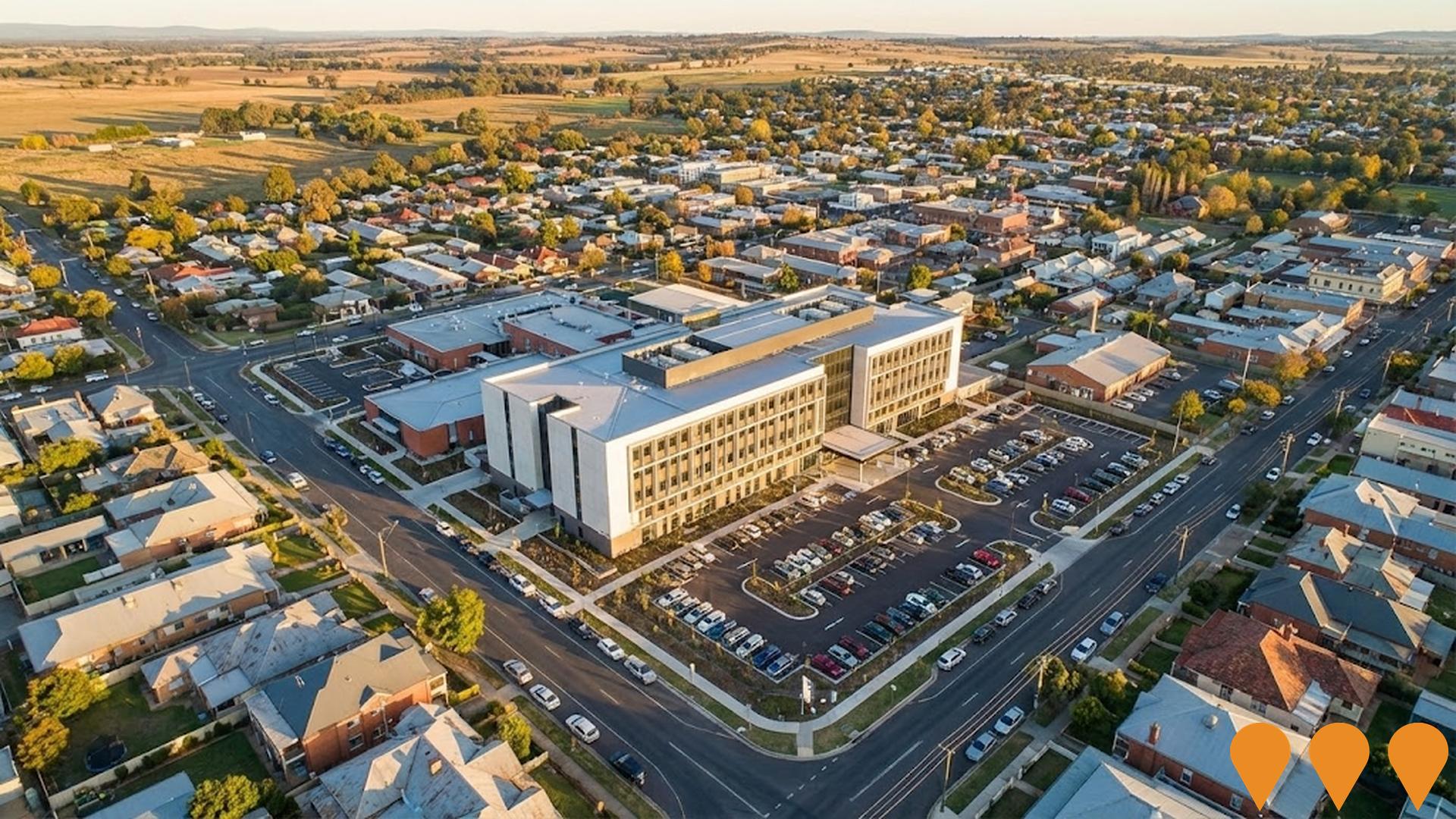
Goulburn Water and Sewer Infrastructure Upgrades
Major upgrades to Goulburn and Marulan's water treatment and sewerage infrastructure, including the Marulan Water Treatment Plant upgrade funded by $27.2 million from the Australian Government, Goulburn Wastewater Treatment Plant expansion to serve up to 40,000 equivalent persons, new water main installations, sewer pump station upgrades, water storage improvements, and water recycling enhancements to support growing population, housing development, and drought resilience.

Waterway Improvement Strategy and River Walkway Development
Comprehensive waterway strategy and action plan to rehabilitate and improve the Wollondilly and Mulwaree Rivers, including river walking tracks and recreational facilities. The project has delivered over 10km of walkways since 2016 with $5.7 million invested. Ongoing work includes waterway rehabilitation, weed removal, native revegetation, and development of recreational linkages across the region. The Wollondilly River Walkway now extends 4km from Marsden Weir to Tarlo Street Bridge with plans for further extension.
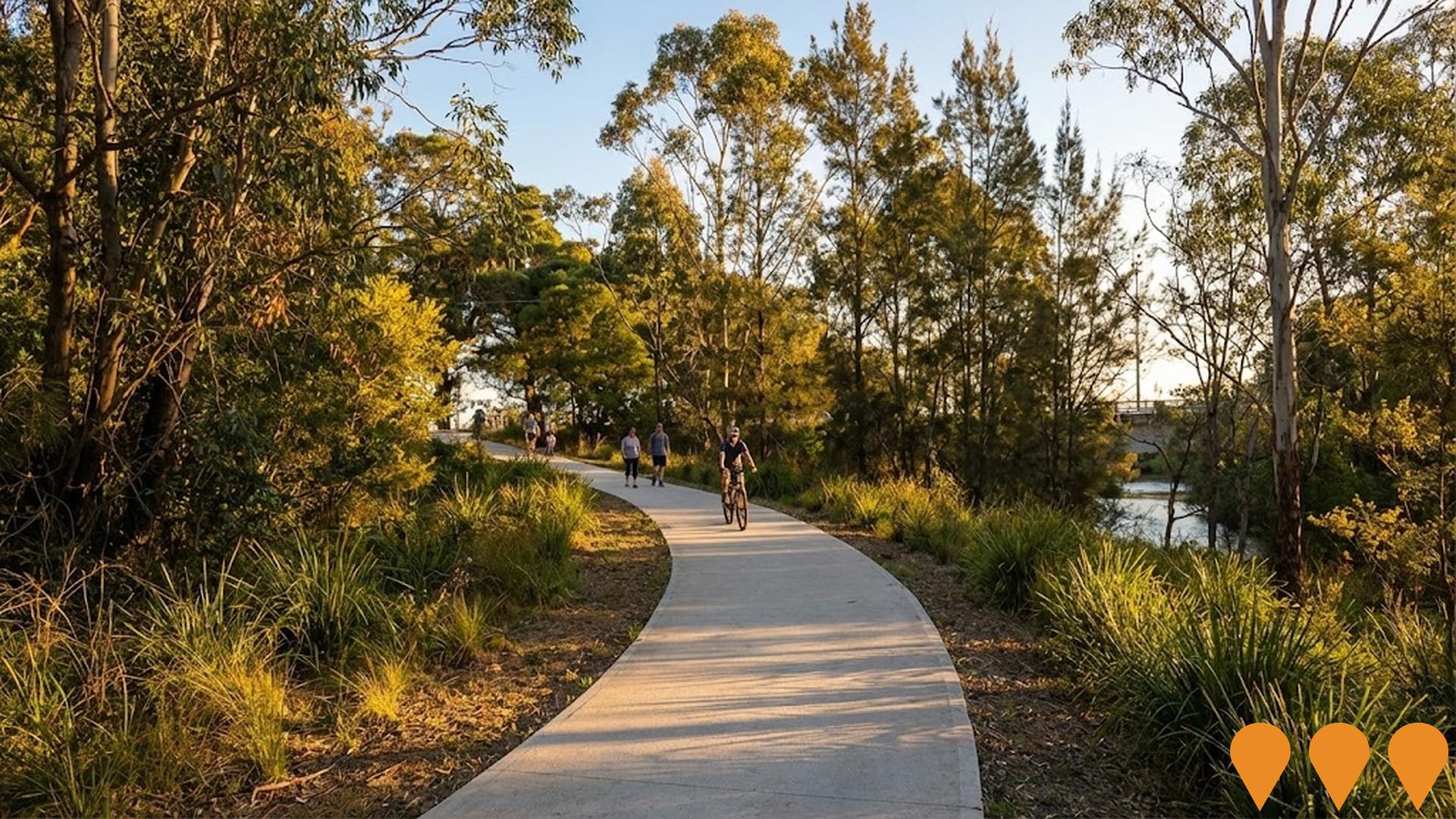
Goulburn Rail Trail
A proposed 25km rail trail within Goulburn Mulwaree Council area, utilizing the historic Goulburn to Crookwell railway corridor from Goulburn CBD to Graywood Siding at Woodhouselee. The trail will link with existing shared pathways and cross the Wollondilly River on a steel lattice bridge. Following Upper Lachlan Shire Council's withdrawal in 2022, the project was revised to focus within Goulburn Mulwaree boundaries. Projected to attract 66,065 visitors annually with $7.3 million economic injection.
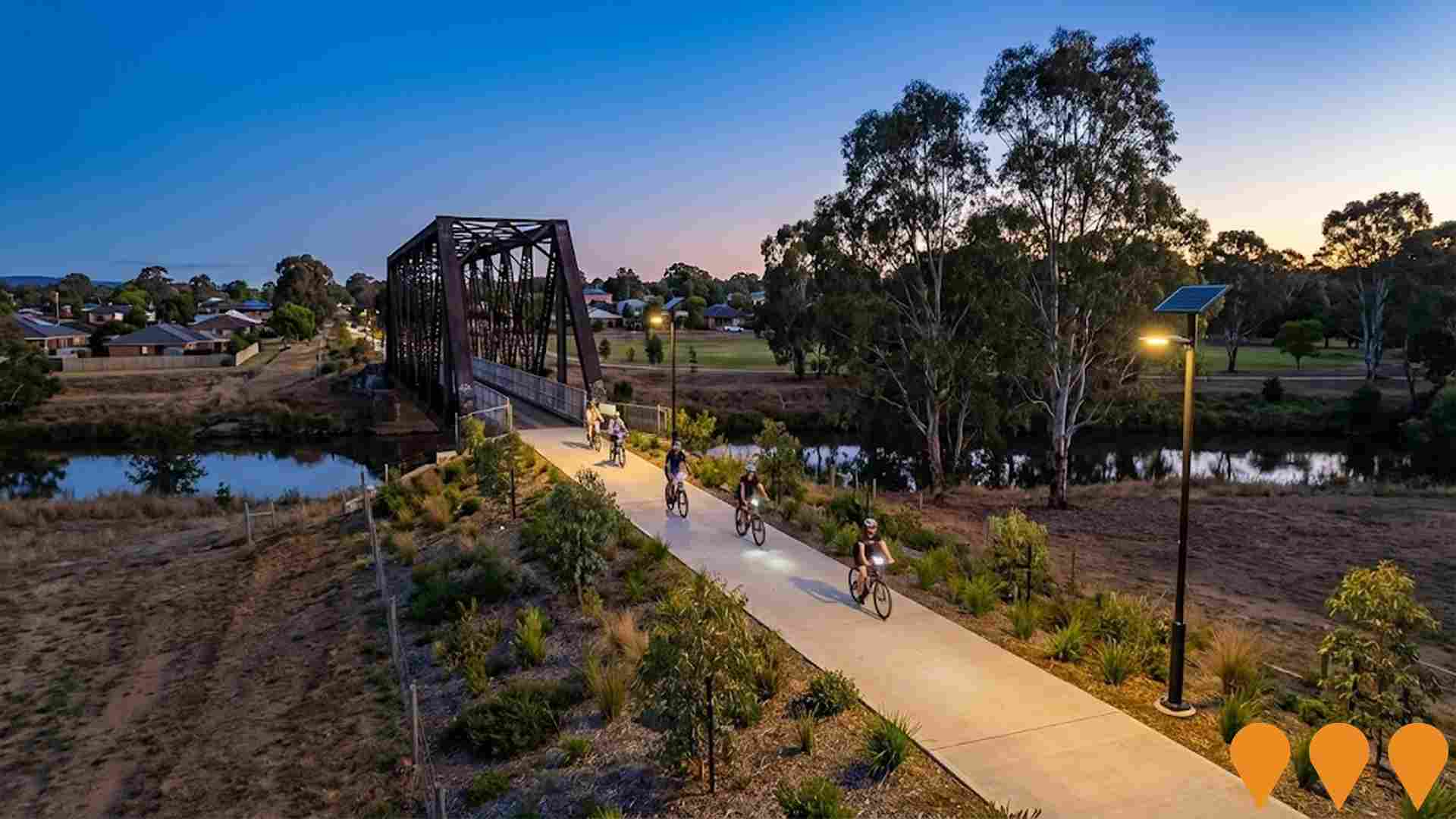
CBD & Surrounds Transformation Project
A strategic planning framework to revitalize Goulburn's CBD by increasing residential density and housing diversity while preserving heritage character. The project proposes amendments to planning controls across four key precincts to accommodate 7000 additional residents expected by 2036, enabling medium-density housing options including 1 and 2-bedroom units. Focus areas include the CBD Core, Northern Gateway Precinct, Southern Gateway Precinct, and Mixed-Use Edge. Currently on public exhibition until August 22, 2025.

Goulburn Community Centre
Development of a modern, sustainable, environmentally friendly purpose-built civic space for community and visitors. The project will act as a central anchor for Council's Community Services Programs and provide community, social, recreation, respite and event opportunities suitable for a wide range of ages and abilities. The project was deferred in September 2023 due to financial constraints but remains a priority project for 2023-2026.
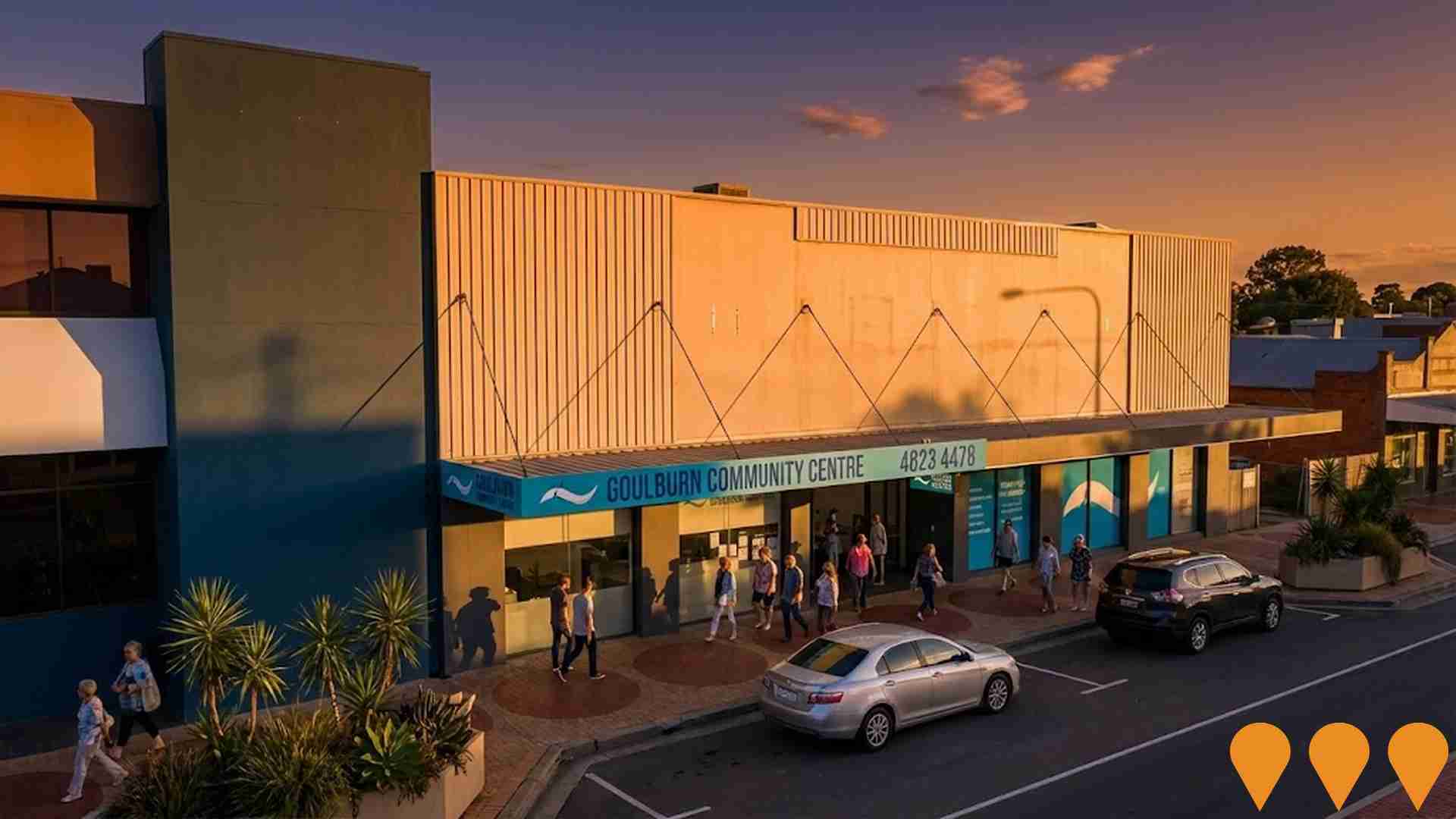
Goulburn Regional Museum and Archive Facility
Development of a comprehensive regional museum and archive facility celebrating Goulburn's close ties to the wool industry. The project aims to make a statement about Australia's First Inland City and the wool industry itself. Investigation encompasses existing large wool stores not far from the Big Merino complex to firm up options for this innovative project.
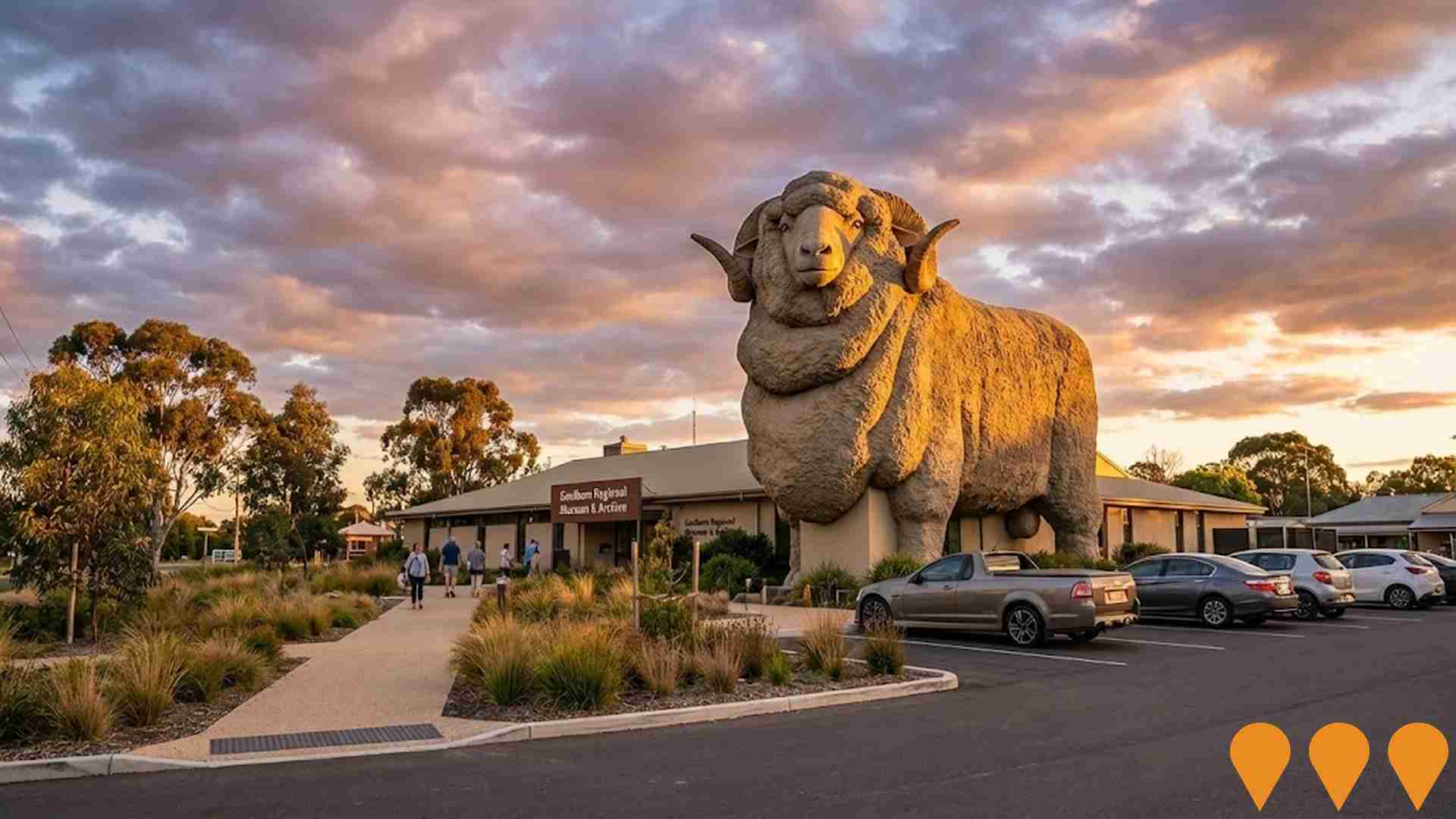
Mistful Park Estate
A 5-stage, 212-lot residential estate development by Ganter Constructions featuring residential blocks from 700-3700sqm, commercial precinct with supermarket opening in 2025, service station construction commencing soon, cafe, and community facilities. Stages 1, 2, 3, and 5 sold out, Stage 4A in progress with 5 blocks remaining in first release and 4 new blocks released.
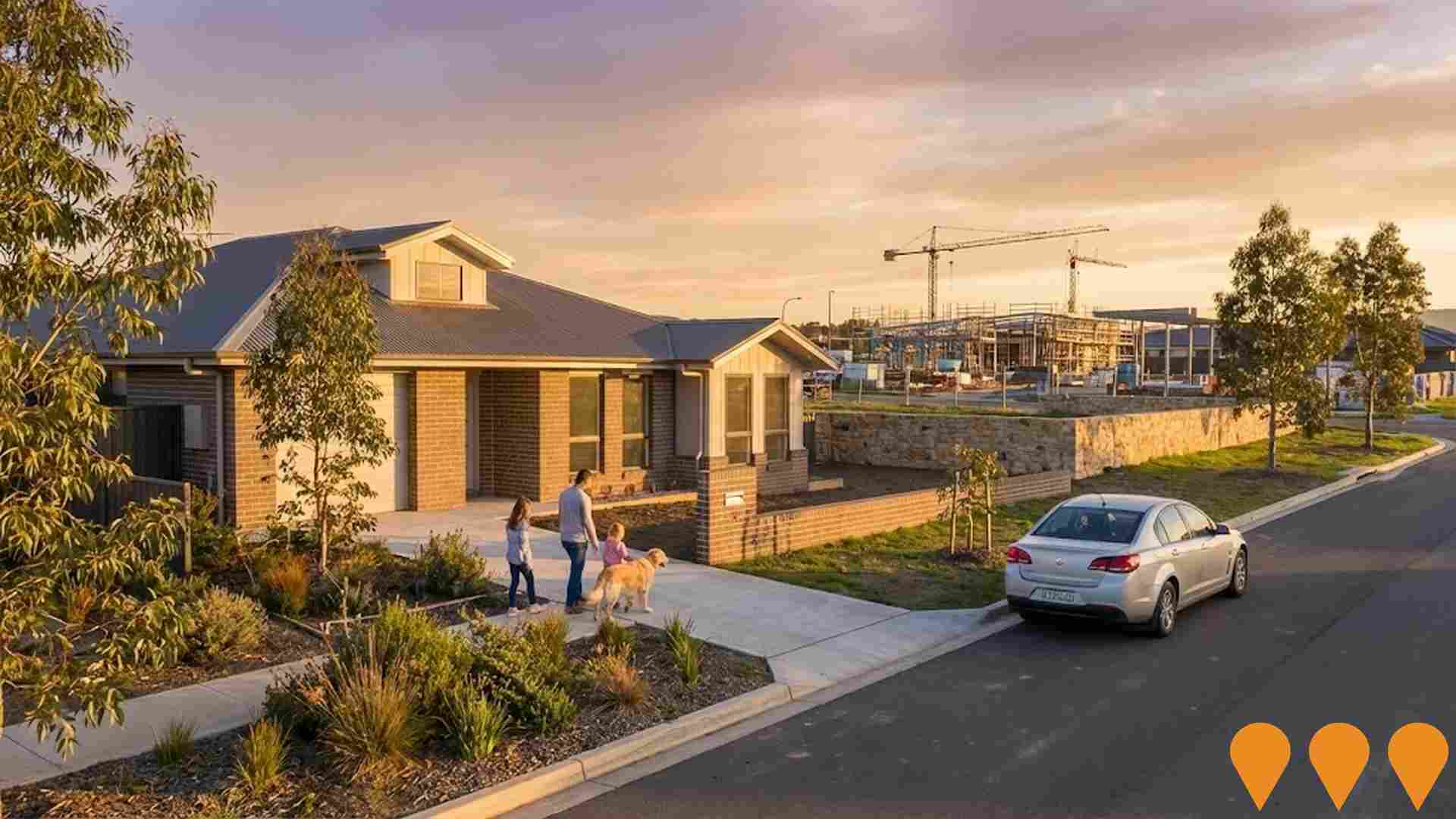
Employment
AreaSearch assessment indicates Goulburn faces employment challenges relative to the majority of Australian markets
Goulburn has a skilled workforce with essential services sectors well represented. The unemployment rate was 4.6% as of June 2025.
At this time, 11,827 residents were employed while the unemployment rate was 0.9% higher than Rest of NSW's rate of 3.7%. Workforce participation in Goulburn is on par with Rest of NSW at 56.4%. The dominant employment sectors among residents are health care & social assistance, public administration & safety, and retail trade. Public administration & safety has particular employment specialization, with a share 1.6 times the regional level.
Conversely, agriculture, forestry & fishing shows lower representation at 1.8% compared to the regional average of 5.3%. Many residents commute elsewhere for work based on Census data comparisons between working population and local population. Between June 2024 and June 2025, Goulburn's labour force decreased by 3.6%, while employment declined by 5.0%, resulting in a rise of 1.4 percentage points in the unemployment rate. In comparison, Rest of NSW saw employment fall by 0.1%, labour force expand by 0.3%, and unemployment rise by 0.4 percentage points. Jobs and Skills Australia's national employment forecasts from May 2025 project national employment growth of 6.6% over five years and 13.7% over ten years. Applying these projections to Goulburn's employment mix suggests local growth of approximately 6.3% over five years and 13.3% over ten years, based on a simple weighting extrapolation for illustrative purposes.
Frequently Asked Questions - Employment
Income
Income levels sit below national averages according to AreaSearch assessment
Goulburn's median taxpayer income was $52,173 and average income was $63,157 in financial year 2022. This is lower than the national average, with Rest of NSW having a median income of $49,459 and an average income of $62,998. By September 2025, estimated incomes would be approximately $58,752 (median) and $71,121 (average), based on Wage Price Index growth of 12.61% since financial year 2022. According to Census 2021 income data, household, family, and personal incomes in Goulburn rank modestly between the 30th and 39th percentiles. The $1,500 - $2,999 income bracket dominates with 31.5% of residents (8,273 people), similar to broader trends showing 29.9% in the same category. Housing affordability pressures are severe, with only 83.8% of income remaining, ranking at the 30th percentile.
Frequently Asked Questions - Income
Housing
Goulburn is characterized by a predominantly suburban housing profile, with a higher proportion of rental properties than the broader region
In Goulburn, as per the latest Census evaluation, 84.6% of dwellings were houses, with the remaining 15.5% comprising semi-detached homes, apartments, and other types. In contrast, Non-Metro NSW had 89.3% houses and 10.7% other dwellings. Goulburn's home ownership rate stood at 34.1%, with mortgaged dwellings at 31.5% and rented ones at 34.5%. The median monthly mortgage repayment in the area was $1,636, lower than Non-Metro NSW's average of $1,694. The median weekly rent figure in Goulburn was $320, compared to Non-Metro NSW's $310. Nationally, Goulburn's mortgage repayments were significantly lower than the Australian average of $1,863, and rents were substantially below the national figure of $375.
Frequently Asked Questions - Housing
Household Composition
Goulburn features high concentrations of lone person households, with a lower-than-average median household size
Family households account for 64.6% of all households, including 24.7% couples with children, 26.1% couples without children, and 12.8% single parent families. Non-family households constitute the remaining 35.4%, with lone person households at 32.7% and group households making up 2.8%. The median household size is 2.3 people, which is smaller than the Rest of NSW average of 2.4.
Frequently Asked Questions - Households
Local Schools & Education
Educational outcomes in Goulburn fall within the lower quartile nationally, indicating opportunities for improvement in qualification attainment
The area's university qualification rate is 17.5%, significantly lower than NSW's average of 32.2%. Bachelor degrees are most common at 11.6%, followed by postgraduate qualifications (3.6%) and graduate diplomas (2.3%). Vocational credentials are prominent, with 41.2% of residents aged 15+ holding them - advanced diplomas at 10.9% and certificates at 30.3%. Educational participation is high, with 29.0% currently enrolled in formal education: 10.8% in primary, 7.5% in secondary, and 3.3% in tertiary education.
There are 15 schools serving 4,656 students, with typical Australian school conditions (ICSEA: 970) and balanced educational opportunities. The educational mix includes 10 primary, 3 secondary, and 2 K-12 schools. School capacity exceeds regional norms (17.8 places per 100 residents vs 13.3), indicating the area serves as an educational center for the broader region.
Frequently Asked Questions - Education
Schools Detail
Nearby Services & Amenities
Transport
Transport servicing is moderate compared to other areas nationally based on assessment of service frequency, route connectivity and accessibility
Goulburn has 291 active public transport stops. These are served by 96 routes, offering 1,635 weekly passenger trips in total. Residents' average distance to the nearest stop is 152 meters.
On average, there are 233 trips per day across all routes, which equates to about five weekly trips per stop.
Frequently Asked Questions - Transport
Transport Stops Detail
Health
Health performance in Goulburn is well below average with prevalence of common health conditions notable across both younger and older age cohorts
Goulburn faces significant health challenges, as indicated by its health data.
Both younger and older age groups experience high prevalence rates for common health conditions. Approximately 51% of Goulburn's total population (~13,447 people) have private health cover, slightly lower than the average SA2 area. The most prevalent medical conditions are arthritis (affecting 11.1% of residents) and mental health issues (9.6%). Conversely, 60.5% of residents report having no medical ailments, compared to 61.3% in Rest of NSW. Goulburn has a lower proportion of seniors aged 65 and over at 20.4% (5,368 people), compared to 21.7% in Rest of NSW. The health outcomes among seniors largely mirror those of the general population.
Frequently Asked Questions - Health
Cultural Diversity
Goulburn ranks below the Australian average when compared to other local markets across a number of language and cultural background related metrics
Goulburn's population showed low cultural diversity, with 87.9% being citizens, 88.5% born in Australia, and 92.7% speaking English only at home. Christianity was the predominant religion, comprising 62.5%, compared to 64.0% in Rest of NSW. The top three ancestry groups were Australian (31.7%), English (31.5%), and Irish (10.0%).
Notably, Australian Aboriginal representation was higher at 3.5% than the regional average of 3.2%. Maltese and Korean populations also showed slight variations, with 0.4% and 0.2% respectively in Goulburn, compared to 0.5% and 0.1% regionally.
Frequently Asked Questions - Diversity
Age
Goulburn's population is slightly older than the national pattern
The median age in Goulburn is 40 years, which is slightly below Rest of NSW's average of 43 but above the Australian median of 38. The 25-34 age cohort makes up 14.8% of Goulburn's population, compared to the Rest of NSW average, indicating over-representation. Conversely, those aged 65-74 comprise only 10.6%, showing under-representation. Between the 2021 Census and present, the 25-34 age group has increased from 13.8% to 14.8%. Meanwhile, the 45-54 cohort has decreased from 11.8% to 11.1%. By 2041, Goulburn's population is forecasted to undergo significant demographic shifts. The 25-34 age group is projected to grow by 1,049 people (27%), reaching a total of 4,937 from the current 3,887. The 15-24 age group is expected to grow at a more modest rate of 4%, adding only 129 residents.


